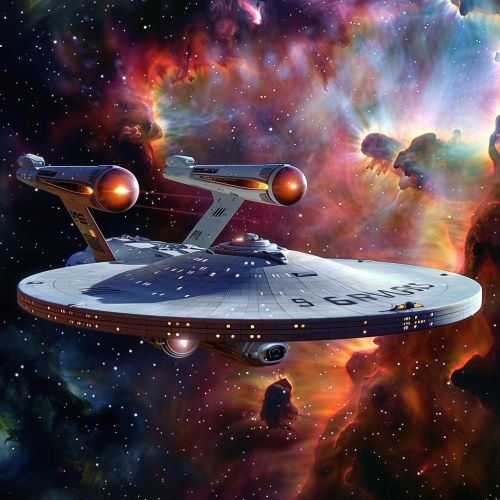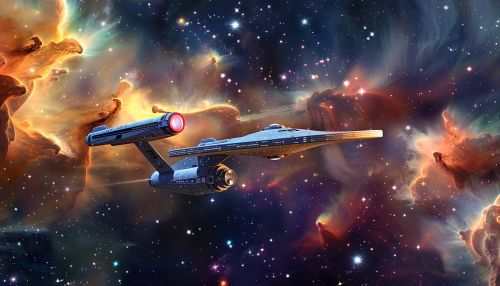Star Trek Into Darkness: Difference between revisions
(Created page with "== Plot == "Star Trek Into Darkness" is a 2013 American science fiction film directed by J.J. Abrams. It is the twelfth installment in the Star Trek film series and the sequel to the 2009 film "Star Trek". The film follows the crew of the USS Enterprise as they are sent on a mission to the Klingon homeworld to capture a former Starfleet member named John Harrison, who has declared a one-man war against the Federa...") |
No edit summary |
||
| (One intermediate revision by the same user not shown) | |||
| Line 20: | Line 20: | ||
Filming began in January 2012 and took place primarily in California. The production utilized a combination of practical effects and CGI to create the film's futuristic settings. The use of IMAX cameras for certain sequences enhanced the visual experience, providing a more immersive viewing experience. | Filming began in January 2012 and took place primarily in California. The production utilized a combination of practical effects and CGI to create the film's futuristic settings. The use of IMAX cameras for certain sequences enhanced the visual experience, providing a more immersive viewing experience. | ||
[[Image:Detail-91939.jpg|thumb|center|USS Enterprise flying through space with a nebula in the background.|class=only_on_mobile]] | |||
[[Image:Detail-91940.jpg|thumb|center|USS Enterprise flying through space with a nebula in the background.|class=only_on_desktop]] | |||
=== Visual Effects === | === Visual Effects === | ||
Latest revision as of 23:02, 18 June 2024
Plot
"Star Trek Into Darkness" is a 2013 American science fiction film directed by J.J. Abrams. It is the twelfth installment in the Star Trek film series and the sequel to the 2009 film "Star Trek". The film follows the crew of the USS Enterprise as they are sent on a mission to the Klingon homeworld to capture a former Starfleet member named John Harrison, who has declared a one-man war against the Federation.
The film begins with Captain James Tiberius Kirk and his crew on a mission to observe the primitive planet Nibiru. When Spock's life is endangered, Kirk violates the Prime Directive to save him, leading to his demotion. However, after a terrorist attack in London orchestrated by Harrison, Kirk is reinstated and ordered to hunt down the fugitive.
The chase leads the Enterprise to the Klingon homeworld of Kronos. Upon capturing Harrison, they discover his true identity: he is Khan Noonien Singh, a genetically engineered superhuman from the 20th century. Khan reveals that he was awakened by Admiral Alexander Marcus to develop advanced weapons and starships to prepare for a war with the Klingons.
Kirk and his crew must navigate a web of deception and betrayal, ultimately confronting both Khan and Admiral Marcus. The film culminates in a battle in San Francisco, where Kirk sacrifices himself to save his ship. Spock pursues Khan, who is eventually captured and placed back into cryogenic sleep. Kirk is revived, and the crew embarks on a new five-year mission.
Production
Development
The development of "Star Trek Into Darkness" began shortly after the release of its predecessor in 2009. J.J. Abrams returned as director, with Alex Kurtzman and Roberto Orci reprising their roles as screenwriters. Damon Lindelof also joined the writing team. The film aimed to explore darker themes and delve deeper into the characters' relationships.
Casting
The principal cast from the 2009 film returned, including Chris Pine as Kirk, Zachary Quinto as Spock, Karl Urban as Dr. Leonard McCoy, and Zoe Saldana as Uhura. Benedict Cumberbatch was cast as Khan, a decision that sparked controversy due to the character's ethnic background in the original series. Peter Weller joined the cast as Admiral Marcus, adding a layer of complexity to the film's narrative.
Filming
Filming began in January 2012 and took place primarily in California. The production utilized a combination of practical effects and CGI to create the film's futuristic settings. The use of IMAX cameras for certain sequences enhanced the visual experience, providing a more immersive viewing experience.


Visual Effects
The visual effects for "Star Trek Into Darkness" were handled by Industrial Light & Magic (ILM), known for their work on the "Star Wars" franchise. The film featured extensive use of CGI to create the various alien worlds, starships, and action sequences. The destruction of San Francisco and the space battles were particularly notable for their technical complexity and visual impact.
Themes
"Star Trek Into Darkness" explores several themes, including the ethical implications of genetic engineering, the consequences of revenge, and the moral dilemmas faced by those in positions of power. The film also examines the bonds of friendship and loyalty among the crew of the Enterprise, highlighting the sacrifices they are willing to make for one another.
The character of Khan serves as a focal point for these themes. His quest for vengeance against Starfleet and Admiral Marcus raises questions about the use of advanced technology for military purposes and the potential for abuse of power. The film also delves into the concept of the Prime Directive, a fundamental principle in the Star Trek universe that prohibits interference with the natural development of alien civilizations.
Reception
"Star Trek Into Darkness" received generally positive reviews from critics, who praised its visual effects, action sequences, and performances, particularly that of Benedict Cumberbatch. However, some fans and critics expressed disappointment with the film's handling of the Khan character and its perceived departure from the philosophical underpinnings of the original series.
The film was a commercial success, grossing over $467 million worldwide. It was nominated for several awards, including an Academy Award for Best Visual Effects.
Legacy
"Star Trek Into Darkness" has left a lasting impact on the Star Trek franchise. It continued the trend of rebooting classic characters and storylines for a new generation, while also pushing the boundaries of visual effects and action in science fiction cinema. The film's exploration of darker themes and moral ambiguity has influenced subsequent entries in the series, including the 2016 film "Star Trek Beyond".
